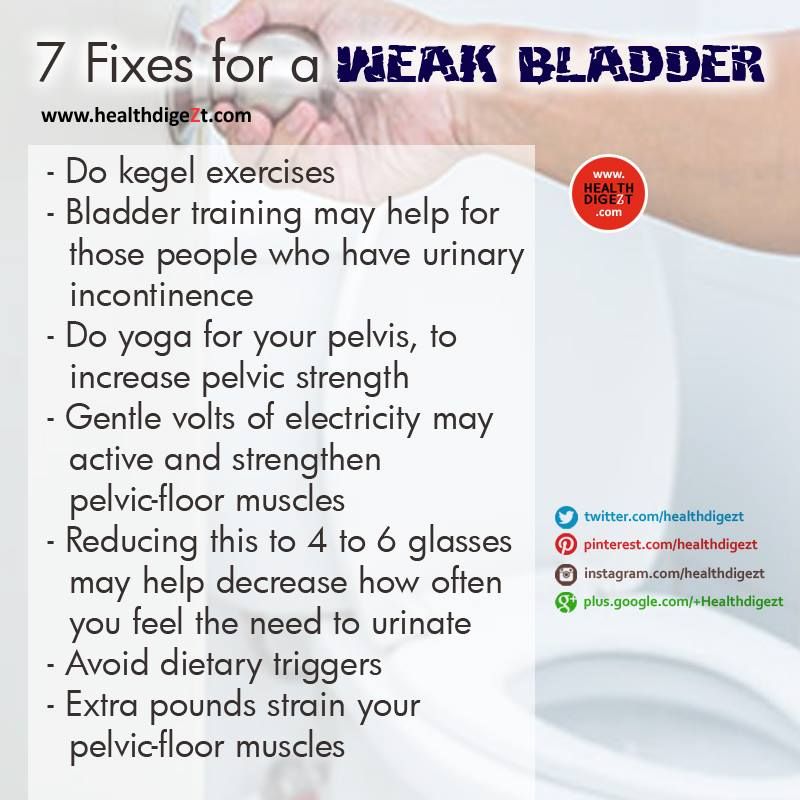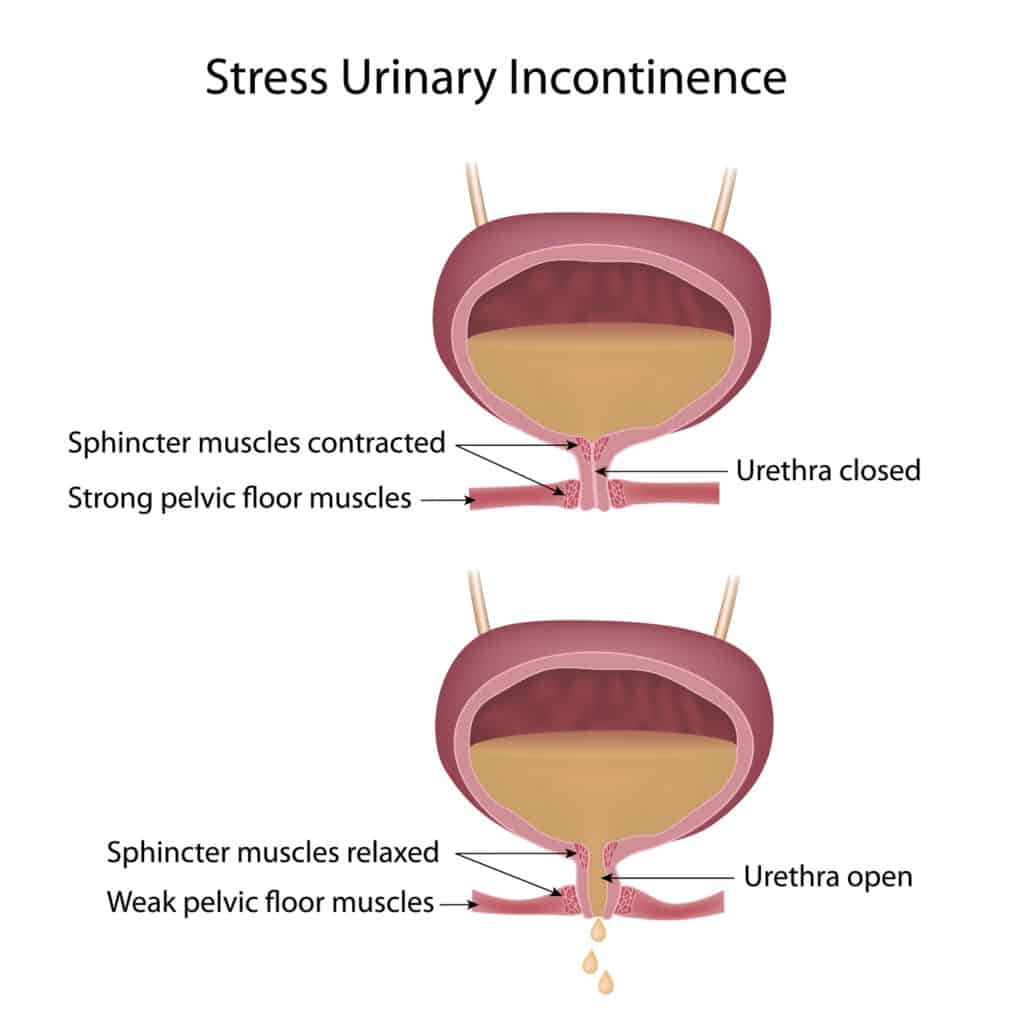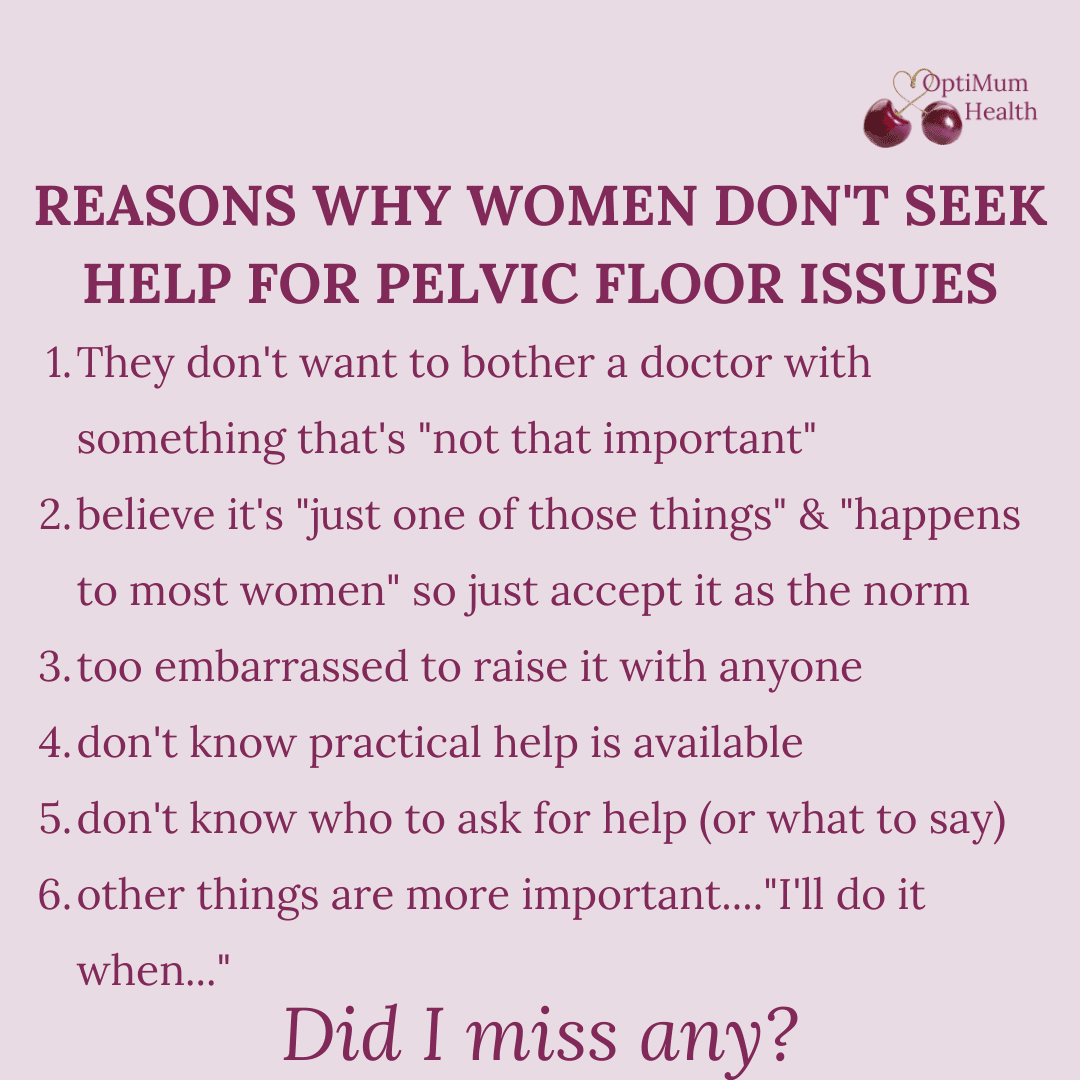Treatment Options For Urgency Incontinence:
- Pelvic floor physical therapy This therapy helps to retrain the bladder.
- Medications A range of medications can help you hold your bladder for longer and decrease your urinary frequency symptoms.
- Botox injections in the bladder Botox relaxes the wall of your bladder in order to prevent it from contracting when it’s not supposed to.
- Peripheral nerve stimulation This treatment uses a needle to stimulate a nerve in your foot that travels up the leg to the spine, where it connects with the bladder and calms it down.
- Sacral neural modulation In this outpatient surgical procedure, a bladder pacemaker is implanted to help control how the bladder is stimulated by the sacral nerve.
“Regardless of which type of incontinence you’re experiencing, it’s important to get evaluated simply because there are so many options for treating urinary incontinence,” says Dr. Lindo. “We always start with conservative treatment approaches, but if those don’t work, you don’t have to continue to suffer. We can help to improve your quality of life.”
Try To Prevent Constipation
Constipation causes the colon to swell and strain because of increased abdominal muscle pressure. This can adversely affect the bladder muscles and may also increase the frequency and severity of OAB symptoms.
Eating more fiber, getting regular exercise, and staying hydrated can help prevent constipation. In addition, there are certain yoga poses including the Crescent Lunge, Cobra, and Legs up the Wall that can help relieve constipation and promote healthy bowel movements.
Those who experience chronic constipation should talk with a doctor to learn more about other ways to help manage their constipation more effectively, such as by taking medications or trying physical therapy.
What Are The Treatments For Urinary Incontinence
Treatment depends on the type and cause of your UI. You may need a combination of treatments. Your provider may first suggest self-care treatments, including:
- Lifestyle changes to reduce leaks:
- Drinking the right amount of liquid at the right time
- Being physically active
- Staying at a healthy weigh
- Avoiding constipation
If these treatments do not work, your provider may suggest other options such as:
- Medicines, which can be used to
- Relax the bladder muscles, to help prevent bladder spasms
- Block nerve signals that cause urinary frequency and urgency
- In men, shrink the prostate and improve urine flow
Read Also: What To Expect After Bladder Sling Surgery
A Detailed History Of The Bladder Diet
The Bladder Diet is a diet plan that has been around for centuries. It was first introduced by the ancient Greeks and Romans.
The Bladder Diet is an eating plan that focuses on foods high in water content like fruits, vegetables, and fish.
It can be difficult to stay on this type of diet because it requires a lot of self-control. Its also hard to follow when youre not used to cutting out certain types of foods from your diet like dairy or meat.
Evaluation Of Urinary Incontinence

Urinary incontinence usually does not indicate a disorder that is life threatening nevertheless, incontinence may cause embarrassment or lead people to restrict their activities unnecessarily, contributing to a decline in quality of life. Also, rarely, sudden incontinence can be a symptom of a spinal cord disorder. The following information can help people decide when a doctor’s evaluation is needed and help them know what to expect during the evaluation.
Also Check: Terminal Bladder Cancer Life Expectancy
Can Overactive Bladder Be Controlled
Overactive bladder therapy can be challenging to manage. However, many people are very satisfied with the treatment they receive and they often see a dramatic improvement in their quality of life. Your doctor will guide you to the best steps to begin with and give you options for any additional treatments you may need over time.
Read Also: Why Do I Get Bladder Infection After Intercourse
What Is The Treatment For Urinary Incontinence
The most appropriate treatment for urinary incontinence will depend on what is causing it.
If the problem is with your pelvic floor muscles, physiotherapy can make a big difference. Medicine can help to relax the bladder muscles, which can help with urge incontinence. Talk to your doctor about whether medicine is right for you.
Some lifestyle changes may also help to treat urinary incontinence. These include:
If medicine, physiotherapy or lifestyle changes dont work, surgery to support your bladder and urethra is an option for some types of urinary incontinence.
You can also try to train your bladder to improve control and increase the amount of urine you can hold. Talk to your doctor or incontinence health professional about a bladder training program.
If you are caring for someone with incontinence, make sure they can access the toilet easily and that its clearly signposted. Make sure their clothing is easy to remove and monitor their routine so you can remind them to go to the toilet regularly. You can read more about caring for someone with incontinence on the Continence Foundation of Australia website.
Read Also: What Tests Are Done For Bladder Cancer
Other Types Of Urinary Incontinence
- Overflow incontinence This occurs when a person is unable to empty their bladder completely and it overflows as new urine is produced. Its often found in people with diabetes or spinal cord injuries.
- Mixed incontinence You show evidence of more than one type.
- Functional incontinence This type of incontinence has less to do with a bladder disorder and more to do with the logistics of getting to a bathroom in time. Its usually found in elderly or disabled people who have normal or near normal bladder control but cannot get to the toilet in time because of mobility limitations or confusion.
- Nocturia The need to urinate twice or more during the night, usually affecting men and women over the age of 60. In men, nocturia can be a symptom of an enlarged prostate.
What Are The Symptoms Of Bladder Control Problems
Signs and symptoms of urinary incontinence can include
- leaking urine during everyday activities, such as lifting, bending, coughing, or exercising
- being unable to hold in urine after feeling a sudden, strong urge to urinate
- leaking urine without any warning or urge
- being unable to reach a toilet in time
- wetting your bed during sleep
- leaking during sexual activity
You May Like: Can They Remove Your Bladder
Can Urinary Incontinence Be Reversed
The term urinary incontinence describes when a person cannot control their urination, to the point that they wet themselves. It can also cause frequent dribbling throughout the day and night. Although urinary incontinence is a common problem, it can be frustrating and embarrassing for those who suffer from it.
If your doctor has recently informed you that you have a form of urinary incontinence or you just suspect it, you may be wondering if the problem will ever go away. The good news about this issue is that you may be able to fully reverse it or at least reduce your symptoms. We describe some of the most common treatment methods for urinary incontinence below.
When Should I See A Healthcare Provider
See a healthcare provider if you experience any symptoms of an overactive bladder.
Age-related OAB may develop gradually and slowly worsen over time. If your symptoms develop suddenly and you have heavy leakage, your OAB may be a symptom of another condition, such as an infection or a neurological issue. Its best to have a provider check these symptoms sooner rather than later.
You May Like: Bladder Retraining For Urge Incontinence
What Is A Bladder Management Program
Bladder training with patient education is an essential component of neurogenic bladder dysfunction management to ensure regular and adequate emptying of the bladder either with a voiding schedule, clean self intermittent catheterization, which is the preferred method of bladder emptying in spinal cord injury or
There are two main types of urinary incontinence:
Stress incontinence
If you have this type, activities that raise the pressure inside your abdomen cause urine to leak through the ring of muscle in your bladder that normally holds it in. Coughing, sneezing, jumping and lifting heavy objects could lead to a leak.
Going through childbirth, smoking or being overweight can raise the risk of stress incontinence for women, Wright says. Stress incontinence in men is rare, and when it arises, its often due to prostate cancer treatment, such as radiation or surgery.
Urge incontinence
With this type, your brain, spinal cord and bladder dont work together properly to allow you to hold and release urine at the right time. Your bladder may suddenly empty itself without warning. Or you may feel like you need to urinate frequently, a problem called overactive bladder.
Some diseases that affect the nervous system, such as multiple sclerosis or stroke, can cause this kind of incontinence, says Wright. In men, an enlarged prostate may be the culprit. But in many cases, doctors dont know what causes urge incontinence.
It is possible to have both types of incontinence at the same time.
Drink Plenty Of Water

Drink 6 to 8 glasses of fluid a day unless your doctor advises you otherwise.
Many people with urinary incontinence avoid drinking fluids, as they feel it causes more problems. However, limiting your fluid intake makes incontinence worse, because it reduces your bladder’s capacity.
Not drinking enough fluid can also cause constipation or make it worse.
Find out which are the healthiest drinks.
You May Like: Do Bladder Infections Make You Tired
Small Lifestyle Changes Can Make A Big Difference
Several factors that can help eliminate or improve urinary incontinence are within your control. For example, losing weight if youre overweight helps to take some of the excess pressure off your bladder. This can significantly help your incontinence! Other things to consider include:
- Exercise regularly: Just 30 minutes of daily exercise has shown to improve urinary incontinence in some studies according to the Mayo Clinic.
- Manage medications: Certain medications such as antihistamines, anti-depressants, diuretics, heart medication, high blood pressure medication, muscle relaxants, and sedatives can all increase urinary incontinence. Talk to your doctor about an alternative if taking one of these aggravates your symptoms.
- Stop smoking: This is especially important if you develop a chronic cough since that problem tends to make urinary incontinence worse.
What Is Urinary Incontinence Symptoms Causes Diagnosis Treatment And Prevention
Urinary incontinence , the involuntary loss of urine, is a very common condition that no one wants to talk about. Because of the stigma that surrounds it, many people are too humiliated to seek help. But most conditions that cause UI can be corrected with medical or alternative interventions.
Occurring much more often in women than men, UI happens when the muscles in the bladder that control the flow of urine contract or relax involuntarily, resulting in leaks or uncontrolled urination. UI itself is not a disease, but it can be a symptom of an underlying medical issue.
Recommended Reading: Kegel Exercise Weights For Bladder Control
Exercises Your Leaky Bladder Wants You To Do
There are exercises for your butt, your legs, your arms, your spare tire, even your ever-texting achy thumbs. So considering the bladder itself is a muscleand its surrounded by other musclesit makes sense that you can whip that puppy into shape, too.
Of course, unless you already have the occasional leakage due to aging, genetics, or childbirth, you might not focus much exercise attention on your bladder. But strengthening those down-there muscles can stop so-called stress incontinence in its tracks, says Candace Howe, MD, a board-certified ob-gyn in private practice in Newport Beach, California. Who wants to undergo surgery? Howe says. Im a surgeon, and I tell my patients I wouldnt want to! If we can fix incontinence with exercise, thats preferable.
When Suzanne Andrews, host of Functional Fitness, was experiencing urinary incontinence after the birth of her son, her doctor told her to consider surgery. As an occupational therapy clinician, Suzanne was seeing patients with the same symptoms and realized her exercise background could help. She created the 30 Day Bladder Fix, a pelvic floor strengthening DVD that combines seated and lying-down exercises to help control incontinence. I remember the day I realized I didnt have it anymore, Andrews says. I sneezed and nothing came out!
Recommended Reading: How Can A Man Strengthen His Bladder
What Are Kegel Exercises
Kegel exercises, also called Kegels or pelvic floor muscle training, are exercises for your pelvic floor muscles to help prevent or reduce stress urinary incontinence. Your pelvic floor muscles support your uterus, bladder, small intestine, and rectum.
Four in 10 women improved their symptoms after trying Kegels.9 Kegels can be done daily and may be especially helpful during pregnancy. They can help prevent the weakening of pelvic floor muscles, which often happens during pregnancy and childbirth. Your pelvic floor muscles may also weaken with age and less physical activity.
Some women have urinary symptoms because the pelvic floor muscles are always tightened. In this situation, Kegel exercises will not help your urinary symptoms and may cause more problems. Talk to your doctor or nurse about your urinary symptoms before doing Kegel exercises.
Read Also: What Is A Bladder Tank
Fixes For Your Leaky Bladder
First, Know Your TypeStressstress incontinenceUrgebadlyurge incontinenceThe Solutions The FixWorks forHow it workssmall studyTry it ifThe American Journal of EpidemiologyThe FixWorks forHow it worksgotta-goTry it ifThe FixWorks forHow it worksTry it ifThe FixWorks forHow it worksTry it ifThe FixImpressaWorks forHow it worksTry it ifPoiseThe FixWorks forHow it worksnowTry it ifThe FixWorks forHow it worksTry it ifThe FixWorks forHow it works1 to 3 monthsTry it if
What Causes Bladder Leaks
There are two main types of urinary incontinence:
Stress incontinence
If you have this type, activities that raise the pressure inside your abdomen cause urine to leak through the ring of muscle in your bladder that normally holds it in. Coughing, sneezing, jumping and lifting heavy objects could lead to a leak.
Going through childbirth, smoking or being overweight can raise the risk of stress incontinence for women, Wright says. Stress incontinence in men is rare, and when it arises, its often due to prostate cancer treatment, such as radiation or surgery.
Urge incontinence
With this type, your brain, spinal cord and bladder dont work together properly to allow you to hold and release urine at the right time. Your bladder may suddenly empty itself without warning. Or you may feel like you need to urinate frequently, a problem called overactive bladder.
Some diseases that affect the nervous system, such as multiple sclerosis or stroke, can cause this kind of incontinence, says Wright. In men, an enlarged prostate may be the culprit. But in many cases, doctors dont know what causes urge incontinence.
It is possible to have both types of incontinence at the same time.
Also Check: Does Overactive Bladder Cause Pain
Other Treatments To Try
In rare cases when all OAB treatment fails and overactive bladder is severe, doctors may recommend one of several types of surgery.
A procedure called bladder augmentation uses part of the bowel to increase bladder capacity. Or, urinary diversion, an alternate route for bladder drainage for severe, complicated OAB patients.
Sacral nerve stimulation. Another procedure implants a small device, similar to a pacemaker, under the skin. The device is connected to a wire, which sends small electrical pulses to nerves around the pelvic floor that control the bladder and muscles surrounding it. This helps build bladder control. Itâs often called a bladder pacemaker. The main limitation with this treatment is that it keeps you from having a spinal MRI.
Percutaneous tibial nerve stimulation. The doctor places a needle on nerves near your ankle that affect bladder control. Youâll have one session a week for 12 weeks and then maintenance treatments as needed. This procedure is done in the office.
An overactive bladder doesnât have to get in the way of your daily life. With a little time, patience, and the right treatment, you can regain control — and peace of mind. Whatever treatment for overactive bladder you and your doctor decide upon, it’s important that you stick with it. If you do, chances are your condition will improve in time.
Show Sources
When Should I See My Doctor

Most women who leak urine after childbirth find that it goes away in the first few weeks, as the stretched muscles and tissues recover.
However, for some women it can take months while other women find their pelvic floor never recovers fully.
If you are still experiencing leakage after 6 months, talk to your midwife or doctor. Dealing with it early on can reduce the risk of it becoming a life-long problem.
Stress incontinence is common, but many women are too embarrassed to talk about it. However, doctors, midwives, maternal and child health nurses and continence nurses are used to talking about it. If you are experiencing leakage, they will have suggestions that can help.
Read Also: Can A Yeast Infection Cause A Bladder Infection